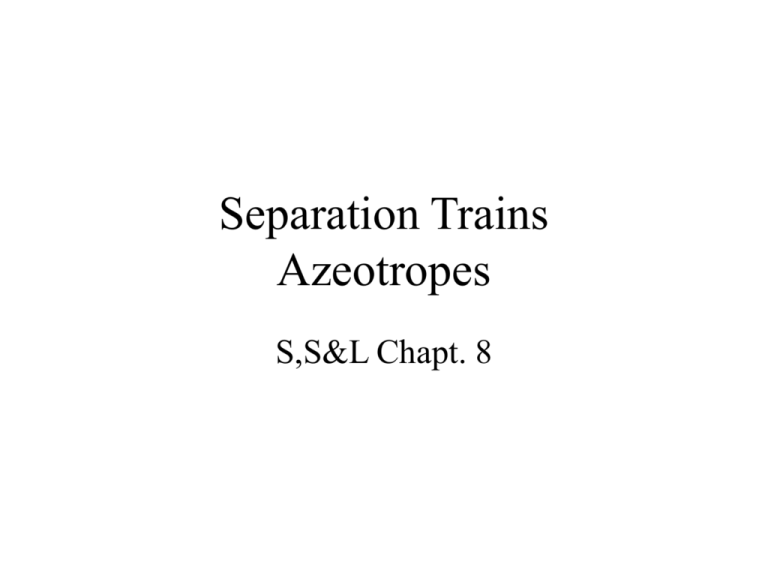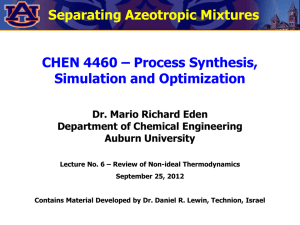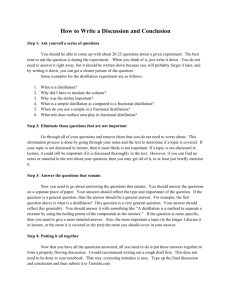L7_Azeotropic Separations
advertisement

Separation Trains
Azeotropes
S,S&L Chapt. 8
What is an Azeotrope?
Introduction
Separation sequences are complicated by the
presence of azeotropes, often involving mixtures of
oxygenated organic compounds:
Alcohols
Ketones
Ethers
Acids
Water
In these cases, distillation boundaries limit the
product compositions of a column to lie within a
bounded region
Prevents the removal of certain species in
high concentrations
Binary
Distillation
IPA/IPE
x
IPA-IPE
x
Mininum-boiling or
Maximum-boiling
Azeotropes
x
Can multi-component Distillations
have Azeotropes?
• Yes!
Azeotrope Conditions
• Conditions on the Activity Coefficient
PT x1 1L P1s (1 x1 ) 2L P2s
Lj 1, j 1,2...C , Positive Deviations from Raoult' s Law
Lj 1, j 1,2...C , Negative Deviations from Raoult' s Law
• Minimum Boiling, γjL> 1
• Maximum Boiling, γjL< 1
• xj=yj, j=,1,2,…C
Raoult’s Law
Pi xi Psat
Homogeneous Azeotropes (Cont’d)
For non-ideal mixtures, the
activity coefficients are
different from unity:
yP x P
yP x P
S
1
1
1 1
2
2
2 2
P x P (1 x ) P
s
1
1 1
1
S
s
2 2
If 1 the mixture has a minimum-boiling azeotrope
i
Example – Phase diagrams for Isopropyl ether-Isopropyl alcohol
Homogeneous Azeotropes (Cont’d)
For non-ideal mixtures, the
activity coefficients are
different from unity:
yP x P
yP x P
S
1
1
1 1
2
2
2 2
P x P (1 x ) P
s
1
1 1
1
S
s
2 2
If 1 the mixture has a maximum-boiling azeotrope
i
Example – Phase diagrams for Acetone-Chloroform
Importance of Physical Property
Data Set
• In all cases
– Need sophisticated liquid phase model to
accurately predict the activity coefficient for the
liquid.
• For High Pressure Cases Only
– Also need sophisticated (non-ideal) gas phase
fugacity model
Two Types of Min. Boiling Azeotropes
• Homogeneous Azeotrope
• Heterogeneous Azeotrope
Overlay with
Liquid/Liquid Separation which is sometimes best separation method
Instructional Objectives
When you have finished studying this unit, you should:
Be able to sketch the residue curves on a tertiary
phase diagram
Be able to define the range of possible product
compositions using distillation, given the feed
composition and the tertiary phase diagram
Be able to define the PFD for a heterogeneous
azeotropic distillation system
Be able to define the PFD for a pressure swing
distillation system
Concepts Needed
• Phase Diagram for 3 phases
• Lever Rule on Phase Diagram
• Residue Curves
Basics: 3-Phase Diagrams
0.2 TBA
0.65
DTBP
0.2 DTBP
0.15 H2O
TBA = Tertiary-butyl alcohol
DTBP = Di-tertiary-butyl peroxide
Basics: 3-Phase Diagrams (Cont’d)
0.2 TBA
0.2 DTBP
0.6 H2O
Basics: The Lever Rule
Residue Curves
Distillation still
Mass balance on species j:
Lx ( L ) y (L L )( x x ), j 1,
j
j
j
j
,C 1
As L 0:
Lx y dL Lx Ldx x dL dLdx , j 1,
j
j
Rearranging:
j
j
dx
j
dL / L
j
j
,C 1
x y x (1 K {T, P, x, y })
j
dx
j
dt
j
j
x y
j
j
j
Multi-component Azeotropes
• Residue Curve Map
– dxj /dť = dxj /d ln(L) = xj – yj
• Integrate from various starting points
Arrows from low to High Temp
Path of the residue composition
Sketching Residue Curves (Exercise)
dx
j
dt
x y
j
j
Distillation
• XB, XF and YD form a
line for a Distillation
Column
• Line can not cross
Feasible Region line
For Partial
Condenser
For Total
Condenser
Distillation Boundaries
• Equilibrium Trays in Total Reflux
Vn
dx
D
xn
yn
y D xn y n , for D 0, L n -1 Vn
dh n 1
Ln 1
Ln 1
• Distillation Lines
xn yn1 , for all n 0,1,...
– xn and yn lie on equilibrium tie lines
– Tangent to Residue Curve
To Create Residue Maps
• AspenPlus
– After putting in the components and selecting
the physical property method
– Choose
• Tools/Analysis/Property/Residue
Residue Curves Liquid Compositions
at Total Reflux
Species balance on top n-1 trays:
L x Dx Vy
n 1
n 1
n
D
n
Approximation for liquid phase:
dx
x x
dh
n
n
n 1
Substituting:
dx
V
D
x
y
x
dh
L
L
n
n
n
n
D
n 1
Stripping section of
distillation column
n 1
At total reflux, D = 0 and Vn = Ln-1
dx
x y
dh
n
n
n
Nodes
Residue Curves (Cont’d)
dx
j
dt
x y
j
j
Residue curves for
zeotropic system
Residue curves for
Azeotropic system
Defining Conditions for Multicomponent Azeotrope
t goes from 0 to 1, ideal to non-ideal to find Azeotrope
Product Composition Regions
for Zeotropic Systems
Product Composition Regions
for Azeotropic Systems
Heterogeneous Azeotropic Distillation
Example: Dehydration of Ethanol
Try toluene
as an
entrainer
What are the zones of exclusion?
Ethanol/Water
Distillation with
Toluene to Break
Azeotrope
M2
S2
D1
S1
M1
Distillation Line
Tie Line
Ethanol/Water
Distillation with
Benzene
To Break
Azeotrope
How To Break Azeotropes with
Entrainer
• Separation Train Synthesis
– Identify Azeotropes
• Some distillations are not Azeotropic and can be
accomplished relatively easily
– Identify alternative separators
– Select Mass Separating Agent or Entrainer
– Identify feasible distillate and bottoms product
compositions
• Residue Curve Analysis
Pressure Swing to
Break Azeotrope
Temp. of
Azeotrope
vs. Pressure
Mole
Fraction
of
Azeotrope
Pressure-swing Distillation (Cont’d)
Example: Dehydration of Tetrahydrofuran (THF)
T-x-y diagrams for THF and water
Other Multi-component Distillation
Problems
• Multiple Steady States
– Run same distillation column with same set
points but different computational starting point
• Get Two or More Different Results
– Top or bottom compositions
– This is real in that the column will have two
different operating conditions!
– Happens most often with multi component
distillation






